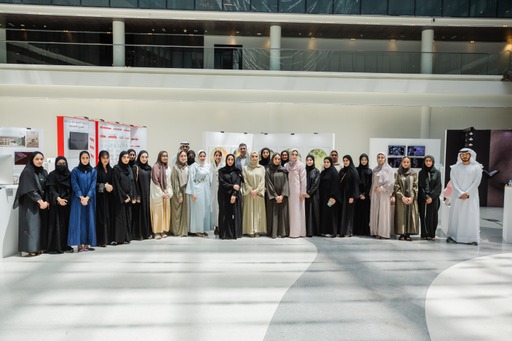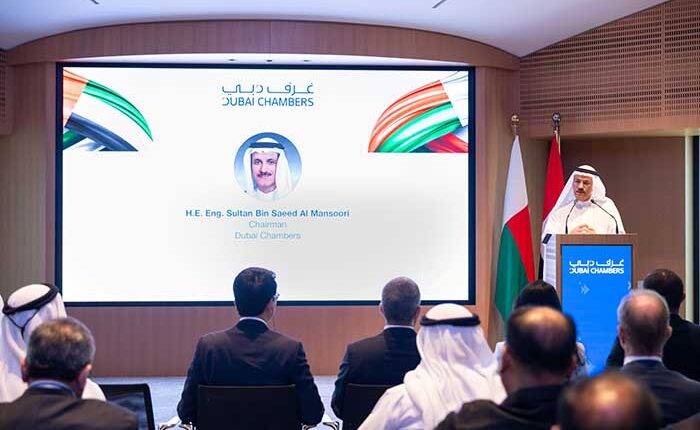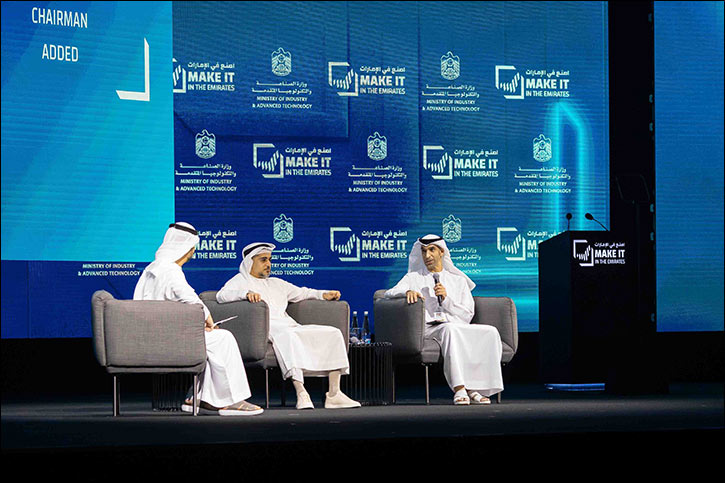Hala Badri, Director General of Dubai Culture and Arts Authority (Dubai Culture), visited the showCACE 2023 Exhibition organised by Zayed University’s College of Arts and Creative Enterprises (CACE) at Dubai Design District until 16 May. This visit is part of the framework of Dubai Culture’s support for emerging local talent in various artistic, cultural and design sectors.
Accompanied by Dr Saeed Mubarak bin Kharbash, CEO of the Arts and Literature Sector at Dubai Culture, Hala Badri toured the eye-catching projects that were distributed in the categories of visual arts, animation, graphic design, and interior design. During her tour, Badri praised the creative ideas and content presented by the graduates that reflected their visions and perceptions of the requirements of society, stressing that the exhibition is an inspiring space to highlight their creativity, experience and knowledge in the sectors.
Badri affirmed that the projects presented align with Dubai’s strategies and visions to enhance sustainability and produce an innovation-centred environment. She also confirmed Dubai Culture’s keenness to support and encourage Emirati talent and empower them by developing and refining their various skills, which comes as part of its responsibilities towards the cultural sector in the emirate in line with Dubai’s vision aimed at cementing the emirate’s position as a global centre for culture, an incubator for creativity, and a thriving hub for talent.
The 2023 showCACE exhibition included a wide array of creations that embodied the ability of Zayed University’s CACE students to innovate, including the ‘Talli’ project by graduate Meera Jassim, in which she presented a model of an artistic line inspired by Talli embroidery, with the aim of exploring the ability of handicrafts to keep pace with current development. Maryam Ali found a source of inspiration in Henna, illuminating through her work the history of the form and its intricate designs. Fatma Mohammed Alshehhi reflected the aesthetics of the Emirati environment and its decorations and colours across her project ‘Abwab’.
In her series of paintings, ‘Appreciation of the Moments,’ Mariam Alfalasi invited the public to appreciate the moments they spend with their loved ones. Mira Aljasmi, within her project ‘Haay Ramsatna’, sought to teach teenagers some vocabulary of the historied Emirati dialect and popular proverbs, while Ayesha Adnan Al Abbar presented her innovative pieces made using biomaterial from date waste. Through ‘Clayable’, Ayesha Ali Khalifa Alzaabi aimed to find new solutions for the high-water temperature in water faucets in the Gulf region using a sustainable approach and environmentally friendly materials.
Via her personal experience in fashion design, Fatma Mohammed Alzarooni created the ‘Textile Finder’ application to help fashion designers choose the fabrics that suit their designs, while Fatma Hamad Aljanahi worked through ‘Al Dabra’ to explore and create new alternative materials made from fruit and vegetable waste and use them as alternative packaging materials. Amna Al Malik’s ‘Waste Re-Imagined’ project aims to reduce food waste and enable community members to design and manufacture innovative furniture pieces based on consumed wastage material and wood, where each tells a unique story.
Mariya Albastaki worked through her project ‘The Stories in Remembrance’ to document the tales and memories of those who lived in Al Fahidi Historical Neighbourhood, while Shamma Alhajeri presented the ‘Al Shail & Al Shbuq’ project to shed light on the materials from which the burqa is made to be essential elements in the design, especially the brilliant shine, and focused through the searches on knowing the quality of the materials used.
The showCACE exhibition also included ‘The Colony’ by graduate Fatma Kherbash, whereby she explores the importance of fungal and microbial diversity in the ecosystem and the impact of climate change on microbial concentration in the land, water, and air. Fatma Saleh Abdulla worked to introduce younger and current generations to Islamic history and culture through her ‘Hijri Months Calendar’. Roodha Alselais’s project ‘Reuniting the Family’ presented specific suggestions for creating spaces in public to ensure the privacy and comfort of family members. In her work, ‘Al Medawi’ (The Healer), Shamma AlRemeithi highlighted the benefits of using natural ingredients instead of laboratory medicines and presented a variety of simple remedies that can be easily prepared at home.
Under the title ‘Nebta – the Emirati Herbal Hero,’ graduate Fatma Jassim showed her innovative project in which she sheds light on the importance of herbal medicine and its positive impact on the body. Osha Ali Almheiri’s ‘Khashm’ is a visual article that researches science and the formation and genes of the Arab nose. Through it, Osha stresses the importance of appreciating the cultural formations related to the nose as an inherited element and not part of the usual facial features.
Through ‘Tajweed’, Maryam Belhoul offered a set of rules that show the correct pronunciation of Quranic words during its recitation, which contributes to understanding the text, feeling spiritual satisfaction, and discovering the aesthetics of the language. Graduate Sheikha Mubarak worked through the ‘Masks and Shadows’ project to enable the public to obtain knowledge in fun ways, while Shayma Almansoori’s series of posters raised the topic of ‘Reading with Dyslexia’ to reveal the importance of paying attention to this phenomenon and treating it using tests and the help of specialised centres.
The 2023 showCACE exhibition includes many other qualitative and innovative projects inspired by Emirati society, culture, environment and heritage.













